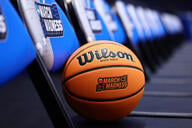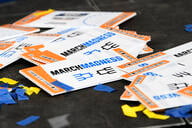You have /5 articles left.
Sign up for a free account or log in.
SAN DIEGO -- As Division III officials prepare to reduce the penalty for athletes who test positive for non-performance enhancing drugs Saturday, new data released here Wednesday showed that use of marijuana and other drugs is highest among athletes in that competitive level.
The data, presented by National Collegiate Athletic Association researchers here at the group's annual convention, are a preview of findings from two quadrennial surveys of 21,000 athletes on their drug use and social environments.
The surveys also found that many athletes are not comfortable outside their athletic social circles, and feel entitled to more flexibility and special treatment from professors.
All three divisions are considering the marijuana policy change, but the proposal is being billed as one of the main items on the Division III legislation agenda here, with Division I focusing on recruiting and athlete welfare items (not to mention governance restructuring), and Division II considering a big academic reform package. Division III also has a significantly smaller-scale drug testing program than its more competitive peers.
Regardless, the policy change must be approved by all three divisions in order to be enacted, because athletes can't be punished differently under NCAA policy.
Twenty-two percent of athletes reported using marijuana in 2013, with Division III smoking the most and Division I smoking the least (as was the case with most drugs). About 29 percent of Division III athletes reported marijuana use, up three percentage points from 2005. Across all divisions, about one in four men smoke, compared to 17 percent of women.
NCAA officials discussed the survey data and substance use among athletes at two sessions here Wednesday.
The proposal would reduce the penalty for students who test positive for "street drugs" such as marijuana from a full year of athletic ineligibility to a half-season. A pamphlet on NCAA drug policies distributed at the convention notes that "marijuana is linked to anxiety and panic reactions, respiratory damage, short-term memory impairment and a decreased focus on goals and achievement." Other "commonly abused" drugs banned by the NCAA are cocaine, anabolic steroids and stimulants.
The NCAA's Committee on Competitive Safeguards and Medical Aspects of Sports proposed the idea for a few reasons: marijuana is not a performance enhancing and is not considered "cheating," so its use should carry a punishment different from those for other drugs; officials want to focus more on helping athletes overcome use and less on punishing them for it; and many who have been punished under the current policy have lost much more than a year of eligibility.
Of the more than 60 athletes who lost eligibility due to marijuana use in 2009-10, only 12 returned, Mary E. Wilfert, NCAA associate director of health and safety and liaison to the committee that proposed the legislation, told Inside Higher Ed.
"We don't want to lose those students, we want them to have the opportunity to come back to their sport and to school," Wilfert said.
At the same time, Division III presidents acknowledged, there is some concern "with the perception that could be associated with reducing the penalty for a positive drug test."
Yet while both the Division III Management and Presidents Councils voted to support the legislation, the latter actually expressed interest in one day abolishing the penalty altogether.
Drug testing is generally on the rise. At least three-quarters of Division I and II and 30 percent of Division III colleges have an institutional drug testing program. Many are testing without "reasonable suspicion," more frequently and with more severe punishment than in years past. The NCAA also tests athletes on campuses and at championship events.
While Divisions I and II have adopted year-round drug testing, Division III presidents have opposed expanding testing beyond championship events.
"They want to focus on education and integration and making sure that we do some collaboration," with groups like NASPA: Student Affairs Administrators in Higher Education, Kari Eckhart, senior woman administrator at Gustavus Adolphus College, said in a presentation Wednesday.
Despite the repercussions it may bring, drug testing should continue and penalties are appropriate, three in five surveyed athletes said. And 57 percent said testing is a deterrent for drug use.
The survey data also showed that Division III athletes are most likely to drink alcohol, and men are "much more likely to drink excessive amounts," said Markie Rexroat, the NCAA's assistant director of research.
Many athletes also reported negative -- in some cases "disturbingly" so, Rexroat said -- consequences of alcohol use. Thirty percent said they experienced memory loss or did something they later regretted because of alcohol, and while a quarter had a friend who criticized their drinking habits, only 6 percent thought they had a drinking or drug problem. Twenty-three percent got into a fight or confrontation while intoxicated in the past year, and while 14 percent drove drunk, only 1 percent were arrested for it.
"These are just a few of the negative situations that can stem from [drinking]," Rexroat said.
However, Wilfert noted in an afternoon session that most students are still reporting that they're neither using nor abusing drugs.
"If students come to campus and believe that the norm is for students to use, they're more likely to use," she said. "We want to be sure that we're putting out the message that most students aren't."
Social Interaction and Academic Entitlement
Many athletes feel stereotyped by their community and professors, yet feel they deserve more of a break than their peers in life and in the classroom, the survey data show.
About 23 percent of athletes said that if their test grades are low, professors should grade on a curve, and one in five say that if they turn in all their class assignments they are entitled to good grades. Another 8 percent believe that faculty are responsible for how they do in class, and half say professors are obligated to be flexible when athletes have conflicts due to games or practices.
However, the NCAA's director of research and academic performance, Lydia Bell, noted that due to lack of research, it's unclear whether athletes are more or less entitled than the general study body.
"For student-athletes who are struggling in the classroom, maybe it's a lack of preparation, challenging material, balancing demands," Bell said. "Some students need to be taught or possibly reminded that grades are earned."
Less than 30 percent of athletes believe most people generally can be trusted, but they have strong confidence in their coaches and teammates. Only 63 percent of male and 58 percent of female students said they feel comfortable among surrounding campus community members, and most are more comfortable around their team than in any other environment.
Perhaps not surprisingly, then, more than half of Division I athletes choose to live with teammates. That figure is just over 40 percent in Division II, and about 25 percent in Division III.
One in three believe students stereotype them and one in five Division I male athletes say faculty do so. One in five men and one in 10 women say they feel stereotyped by the surrounding community.
These findings suggest that colleges should reconsider how they encourage athletes to engage outside their team environment, Bell said.




